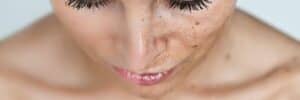
DID YOU KNOW?
Melanin is the name of the pigment that gives our skin, hair eyes their natural colour. Whilst all skin colors contain the same number of melanin-producing cells, darker skins produce more melanin than fairer skins. Although the base skin colour we are born with remains the same for life, patches of excess pigment production such as freckles, age spots and hormonal pigment (melasma) can create complexion imbalance leaving an uneven and blotchy tone. Melanin is naturally present within the skin to protect against UV (ultraviolet) damage. It is, for this reason, that the skin tans with prolonged exposure to sunlight. Sun damage, trauma and hormones can all trigger excess melanin production, resulting in dark spots, shadowing and unsightly blemishes.
Irrelevant whether pigmentation is sourced genetically (such as freckles that appear during childhood), hormonally or through sun exposure, melanin overproduction is activated via UV exposure. UVB rays (often associated with sunburn) create slow tanning of the skin, whilst deeper penetrating UVA rays associated with skin ageing) accelerate the oxidation (or darkening) of melanin and provide more rapid tanning and skin pigmentation.
Although the base skin colour we are born with cannot be changed or altered, accumulated pigmentation stimulated by UV exposure may be successfully treated, faded and in some cases prevented.
SKIN FACTS
- Sunscreen is the most effective preventative against pigmentation.
- Freckles that appear during childhood (approximately ages 4-7) are primarily genetically sourced pigmentation that occur most commonly on fairer complexions with light hair colour.
- All skins produce melanin to varying degrees. Darker skins are more prevalent in black based melanin whereas fairer skins are more prevalent in yellow-based melanin. Albinism is a condition where the body cannot produce melanin at all.
- All forms of excess melanin production (or pigmentation) with the exception of the skin’s natural base colour are stimulated and accelerated by UV exposure.
- Excess pigmentation may occur after trauma (such as burns, friction or prolonged inflammation).
- The darker the skin’s base colour, the more prone it can be too uneven melanin deposition.
- Women account for 90% of hormonal pigment cases. The key triggers are pregnancy or medication such as the contraceptive pill.
- As the skin’s natural base colour is genetically determined, it cannot be lightened or permanently changed in any way.
CAUSES OF CONDITION
Pigmentation and uneven skin tone have four contributing factors that should be taken into account in order to provide effective reduction and prevention. These include:
- Genetic sources
- Hormonal triggers
- Skin trauma
- Ultraviolet radiation
Freckles that appear during childhood (approximately ages 4-7) are a form of genetically sourced pigmentation. As this overproduction of melanin is a hereditary condition that occurs at such a young age, it can be harder to treat years later during adulthood. Any subsequent sun exposure post product and treatment will re-stimulate their production and appearance.
Known as melasma or chloasma (the ‘mask of pregnancy’), any trigger that affects melanin hormonal production may accelerate the formation of hormonal pigmentation. The contraceptive pill, hormone replacement therapy and pregnancy are the key triggers which are then activated by UV exposure. Hormonal pigmentation is the hardest form of discolouration to treat as it generally sits within the lower layers of the skin.
Often called post-inflammatory pigmentation, darker skin tones are most prone to this form of melanin stimulation. Often activated by repeated trauma, heat, friction, burns or even minor inflammation from picking or squeezing the skin, brown marks or shadows remain after the initial site of injury or irritation. These marks may slowly fade over time as the skin naturally heals.
Curtesy Omniderm 2017
Restoring Your Skin Facial that really makes a difference https://dermalessence.com.au/services/signature-facials/
You can book that appointment here: https://dermalessence.com.au/book-your-appointment/
